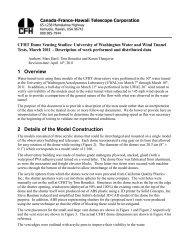ALLEN BRADLEY 1747-L551 PLC Processor
ALLEN BRADLEY 1747-L551 PLC Processor
ALLEN BRADLEY 1747-L551 PLC Processor
Create successful ePaper yourself
Turn your PDF publications into a flip-book with our unique Google optimized e-Paper software.
7–4<br />
Wiring Your I/O Modules<br />
Preparing Your Wiring<br />
Layout<br />
Careful wire routing within the enclosure helps to cut down electrical<br />
noise between I/O lines. Follow these rules for routing your wires:<br />
• Route incoming power to the controller by a separate path from<br />
wiring to I/O devices. Where paths must cross, their intersection<br />
should be perpendicular.<br />
Important:<br />
Do not run signal or communications wiring and<br />
power wiring in the same conduit.<br />
• If wiring ducts are used, allow for at least two inches between I/O<br />
wiring ducts and the controller. If the terminal strips are used for<br />
I/O wiring, allow for at least two inches between the terminal<br />
strips and the controller.<br />
• Limit the cable length for the TTL input module to 15.24 m<br />
(50 ft) per point and 3.05 m (10 ft) per point for the TTL output<br />
module. Use low power DC I/O wiring even though it is less<br />
tolerant to electrical noise.<br />
!<br />
ATTENTION: Handle the TTL module by its ends,<br />
not metallic surfaces. Electrostatic discharges can<br />
damage the module. Do not expose the TTL module to<br />
electrostatic charges.<br />
• Segregate I/O wiring by signal type. Bundle wiring with similar<br />
electrical characteristics together.<br />
Wires with different signal characteristics should be routed into the<br />
enclosure by separate paths. Refer to Allen-Bradley Programmable<br />
Controller Grounding and Wiring Guidelines, Publication Number<br />
1770-4.1.<br />
!<br />
ATTENTION: If the controller is being installed<br />
within a potentially hazardous environment (that is,<br />
Class I, Division 2), all wiring must comply with the<br />
requirements stated in the National Electrical Code<br />
501-4 (b).<br />
Publication <strong>1747</strong>-6.2




![Documentation [PDF] - Canada France Hawaii Telescope ...](https://img.yumpu.com/26965302/1/190x245/documentation-pdf-canada-france-hawaii-telescope-.jpg?quality=85)







